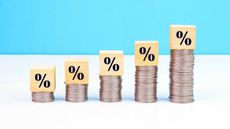5 Best Commodity ETFs to Buy Now
These commodity ETFs offer investors exposure to the diverse asset class, which is a helpful hedge against inflation.


Investors worried about sticky inflation should take a closer look at commodity ETFs as hedges against rising prices.
Why?
History shows that commodities have proven resilient amid persistently rising prices. From energy sources to agricultural products to metals, commodities of many different flavors have naturally seen their values rise amid inflationary pressures.
Inflation is cooling, but still remains high
The U.S. inflation rate ran at an 8.0% clip in 2022 and at 4.1% in 2023. And while inflation has edged down to "only" 3.3% as the U.S. Bureau of Labor Statistics reported in May CPI report, commodity prices remain elevated
"We can safely say that we are past peak inflation, but it is too early to call victory against inflation," says Gargi Chaudhuri, head of iShares Investment Strategy, Americas at BlackRock. "Investors should continue to think about hedging against inflation and consider how higher interest rates for longer could affect their portfolios."
Why should you invest in commodity ETFs?
One way to hedge against rising prices is to hold a position in commodity ETFs that own a basket of key materials used in the global economy. After all, energy products, metals and agriculture often see their values rise amid inflationary pressures, because such sectors are the first link in the supply chain for many goods.
Still, the idea of engaging directly with commodity markets can be intimidating for investors. Many online brokers require a separate account or at least separate controls to trade futures, and even if you get over that hurdle, there's always the question of what to buy and sell – and when.
The five commodity ETFs featured here can take some of the guesswork out the equation. To compile this list of the best ETFs focused on this diverse asset class, we looked for funds that are benchmarked to physical commodity markets, have more than $1 billion in assets under management, and provide a simple one-stop way to invest in your normal brokerage account.

To continue reading this article
please register for free
This is different from signing in to your print subscription
Why am I seeing this? Find out more here

Invesco Optimum Yield Diversified Commodity Strategy No K-1 ETF
- Assets under management: $5.2 billion
- Expenses: 0.59%, or $59 annually for every $10,000 invested
Though there are a lot of terms in its name, the Invesco Optimum Yield Diversified Commodity Strategy No K-1 ETF (PDBC) is self-explanatory when you walk through each one. In a nutshell, asset manager Invesco offers this fund to folks seeking a high-yield way to invest in a diversified basket of commodites, but without extra paperwork.
That's where the "no K-1" comes in. Anyone who has sunk money into more sophisticated instruments like master limited partnerships (MLPs) or S corporations knows how much of a headache these investments can be.
This is because they can require K-1 tax forms for any investment that functions as a partnership – which, believe it or not, can apply to many publicly traded stocks or exchange-traded products. And when you invest in a partnership, you are taxed instead of the entity itself, and therefore have to reflect your share of the investment's earnings, losses, deductions, credits and various other items on your personal returns each April.
PDBC takes this sometimes onerous step out of the process.
And, of course, low-risk investors love diversification and yield. Fossil fuels lead the portfolio with commodity investments in oil and gasoline, but other materials, such as gold, copper, wheat and corn, are also key assets.
And with a dividend yield of about 4.0%, you'll get roughly three times the income potential of the S&P 500 even as you get direct commodity exposure. No wonder PDBC is one of the leading commodity ETFs out there.

First Trust Global Tactical Commodity Strategy Fund
- Assets under management: $2.4 billion
- Expenses: 1.02%
The First Trust Global Tactical Commodity Strategy Fund (FTGC) sounds the same on paper as the prior PDBC fund in that it forgoes a K-1 tax formand invests in a diversified group of commodities. However, the "tactical" term in its name is what matters, as this actively managed fund has cooked up an approach that's delivered 9% for the year to date compared to just 7% for the prior PDBC fund.
Top holdings in this active ETF currently include gasoline, gold, copper, sugar and soybeans. This access to a diversified mix of commodities theoretically reduces risk by spreading your cash around, but remember that active management cuts both ways. There's no guarantee that past performance will add up to future profits, but for investors who want to look beyond some of the more vanilla commodity ETFs out there, FTGC offers a decent alternative.
It's also worth noting that the expenses for FTGC are higher than other funds on this list. But the fund's performance on the price charts is a big reason this First Trust commodity fund commands billions in assets despite being a bit pricier than some of its peers.

Invesco DB Commodity Index Tracking Fund
- Assets under management: $1.8 billion
- Expenses: 0.85%
The Invesco DB Commodity Index Tracking Fund (DBC) is another billion-dollar commodity ETF. It seeks to track a group of the 14 most-heavily traded commodity futures contracts via a more passive approach that sticks to a weighted Deutsche Bank index of popular goods.
DBC is admittedly pretty energy heavy, with more than 50% of assets in related holdings.
These include gasoline, two types of crude oil futures (the European contract tied to Brent in the North Seas and the West Texas contract) as well as low-sulfur diesel fuel. But, given some of the concerns over energy lately, that may be a feature and not a bug that has drawn in many investors.
Interestingly, the more passive nature of this index fund doesn't result in lower costs that you might expect from traditional stock or bond funds. That said, the annual expenses tally just $85 on $10,000 invested, which is affordable for many traders who aren't interested in actively managing their own futures account.

United States 12 Month Oil Fund
- Assets under management: $1.2 billion
- Expenses: 0.70%
If you want to go all in on the energy commodity side, the United States Oil Fund (USO) is perhaps the best option among commodity ETFs right now.
But don't confuse this product with its sister fund, the United States 12 Month Oil Fund LP (USL), which holds futures contracts spread across the next 12 months. That can provide a longer-term outlook as well as a reduced volatility profile, but USL isn't particularly liquid with fewer than $100 million in assets.
In addition to simply being larger and more established, USO is focused on near-term contracts, with the majority of its assets as of this writing in the August futures contracts for West Texas Intermediate crude. That's admittedly not a 1:1 link to the fluctuations you'll see in crude oil day-to-day, so if you really want to swing-trade oil prices, you should learn how to trade futures directly. But if you're looking for simple exposure to immediate trends via an indirect exchange-traded product, USO is a great option.

SPDR Gold Trust
- Assets under management: $62.5 billion
- Expenses: 0.40%
Of course, gold is considered one of the most popular hard asset hedges against inflationary pressures. For investors looking for a fixed tie to this precious metal without the hassle of storing heavy bullion or bars at home, the SPDR Gold Trust (GLD) is the most popular way to play this commodity.
This fund admittedly has plenty of competitors among gold ETFs on Wall Street. These include the cheaper bullion-backed iShares Gold Trust (IAU) that offers a lower annual expense ratio and even the SPDR Gold MiniShares (GLDM). However, you'll note that GLD is still the cheapest fund on this list of the best commodity ETFs, so it'll hardly cost you an arm and a leg.
Furthermore, it has the deepest pool of liquidity among any exchange-traded gold vehicles. As such, you simply cannot find a more established way to play physical gold than GLD unless you were to literally lug the precious metal around.
Learn more about GLD at the State Street Global Advisors provider site.
Related content
Get Kiplinger Today newsletter — free
Profit and prosper with the best of Kiplinger's advice on investing, taxes, retirement, personal finance and much more. Delivered daily. Enter your email in the box and click Sign Me Up.

Jeff Reeves writes about equity markets and exchange-traded funds for Kiplinger. A veteran journalist with extensive capital markets experience, Jeff has written about Wall Street and investing since 2008. His work has appeared in numerous respected finance outlets, including CNBC, the Fox Business Network, the Wall Street Journal digital network, USA Today and CNN Money.
-
 Beryl Portends a Harsh Hurricane Season: Are You Ready?
Beryl Portends a Harsh Hurricane Season: Are You Ready?Hurricane Beryl is breaking records as the first hurricane of the season. Do you have the insurance you need?
By Erin Bendig Published
-
 Stock Market Today: Markets Set Fresh Highs as CPI, Earnings Loom
Stock Market Today: Markets Set Fresh Highs as CPI, Earnings LoomStocks wavered on light volume ahead of a busy week for economic news and corporate earnings.
By Dan Burrows Published
-
6 Best Books on Investing
investing These six books will help you be a better investor.
By Coryanne Hicks Last updated
-
Can Stocks Picked by Artificial Intelligence Beat the Market? 3 Stocks to Watch
stocks An artificial intelligence stock-picking platform identifying high-potential equities has been sharp in the past. Here are three of its top stocks to watch over the next few months.
By Dan Burrows Last updated
-
5 Stocks to Sell or Avoid Now
stocks to sell In a difficult market like this, weak positions can get even weaker. Wall Street analysts believe these five stocks should be near the front of your sell list.
By Dan Burrows Published
-
Choosing Between Look-Alike ETFs and Mutual Funds
If you're trying to choose between ETFs and Mutual Funds, some factors to help you decide are how you trade and the type of account you plan to use.
By Nellie S. Huang Published
-
Best AI Stocks to Buy: Smart Artificial Intelligence Investments
tech stocks AI stocks have been red-hot in recent months and the technology's relentlessly growing importance should keep the sun shining on them.
By Tom Taulli Last updated
-
Best Stocks for Rising Interest Rates
stocks The Federal Reserve has been aggressive in its rate hiking, and there's a chance it's not done yet. Here are eight of the best stocks for rising interest rates.
By Jeff Reeves Last updated
-
The 5 Safest Vanguard Funds to Own in a Bear Market
recession The safest Vanguard funds can help prepare investors for continued market tumult, but without high fees.
By Kyle Woodley Last updated
-
The 5 Best Inflation-Proof Stocks
stocks Higher prices have been a major headache for investors, but these best inflation-proof stocks could help ease the impact.
By Louis Navellier Published








